DA3-03M/RGBW
Dimming actuator for RGBW strips
Overview of devices
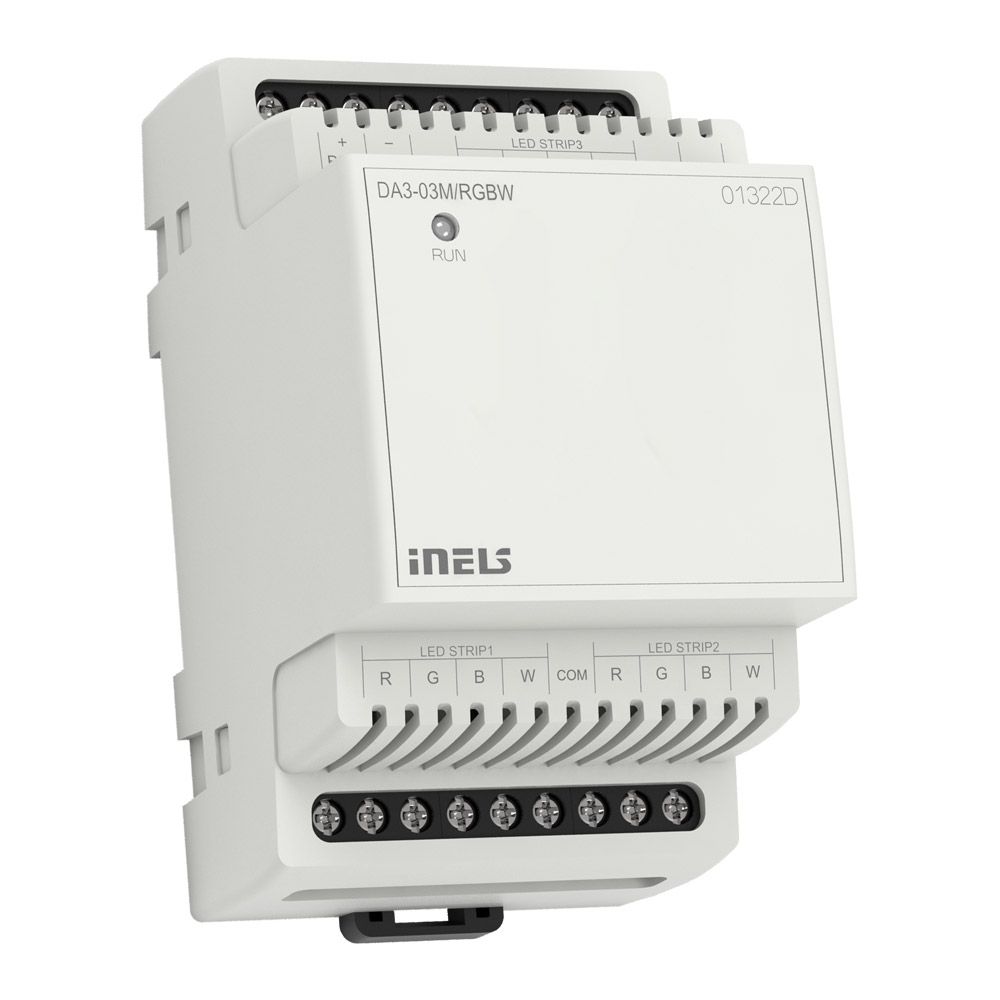
Key Features
Channel Configuration: The dimmer is designed for independent control of 12 channels. It can be connected to various LED strip configurations, including:
- 3 RGBW LED strips or 3 RGB LED strips,
- 12 single-color LED strips, or
- A combination of RGB, RGBW, and single-color LED strips.
Load Capacity and Design: The 3-module design of the dimmer allows the connection of a dimmable load of 3x 15 A or 12x 3.75 A. For example, this can support 3 pieces of RGBW LED strips with 24 V and 20W/m, totaling a maximum of 18 meters.
Control Mechanism: The dimmer is controlled by the central unit of the iNELS system. This central control mechanism allows for coordinated and centralized management of the connected LED strips.
Power Supply Range: The power supply of the LED strip is in the range of 0-50V DC. This indicates compatibility with a variety of LED strips within the specified voltage range.
Separate Control and Addressability: Each of the 12 output channels is separately controllable and addressable. This individual control and addressability provide flexibility in managing different LED strips connected to the dimmer.
Electronic Thermal Protection: The dimmer is equipped with electronic thermal protection. This protection feature automatically switches off the output in case of overheating, ensuring safety and preventing damage.
Installation Requirements: During installation, it is necessary to leave at least half a module of free space on each side of the actuator for better cooling. This requirement emphasizes the importance of proper ventilation and cooling for optimal performance.
Mounting and Design Specification: The DA3-03M/RGBW dimmer is designed in a 3-MODULE format. It is intended for installation on a switchboard on an EN60715 DIN rail.
Exemplary circuit diagram/ Wiring Diagram
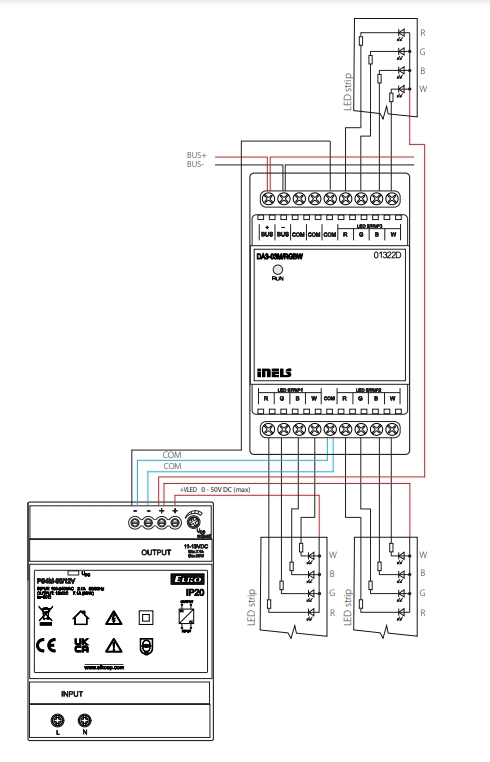
Compatibility chart ( CU, minimal FW version and Integration)
1
CU3-01M
02.00.01
NA
NA
2
CU3-02M
02.00.01
NA
NA
3
CU3-07M
02.00.01
Yes
Yes
4
CU3-08M
02.00.01
Yes
Yes
6
CU3-09M
Preparation
Preparation
Preparation
7
CU3-10M
Preparation
Preparation
Preparation
Programming in iDM
Introduction
iNELS Design Manager, or IDM3, is for programming iNELS units. This software serves as the platform for configuring device parameters, defining functions, and executing the programming required for iNELS units.
Device parameters, such as sensor range and thresholds, backlights, and operational modes, can be easily adjusted within the IDM3.
The process of programming in IDM3 typically involves defining functions and establishing logical connections between different devices. This allows for the creation of automation scenarios and the implementation of intelligent control strategies.
Starting up
Select the "blue control icon" as shown in Fig 1 > Clicking on the option "New project from default template“ allows you to create a new project from a predefined template.
Select the "Device manager" (Fig 1)> Add "New unit "> Select the central unit > Add "New unit">Select the "Internal-Master/ BUS"> Add "New unit "> Add the devices> Click on the devices to see the "Parameters".

Parameters:
Parameters in the iNELS devices refer to the measurable factors or characteristics that define the behavior or performance of the device. These could include electrical properties, physical dimensions, environmental conditions, and various other specifications depending on the type of device.
These are settings specific to individual devices within your automation system. The specific parameters of the DA3-03M/RGBW in the iDM as shown in Fig.2
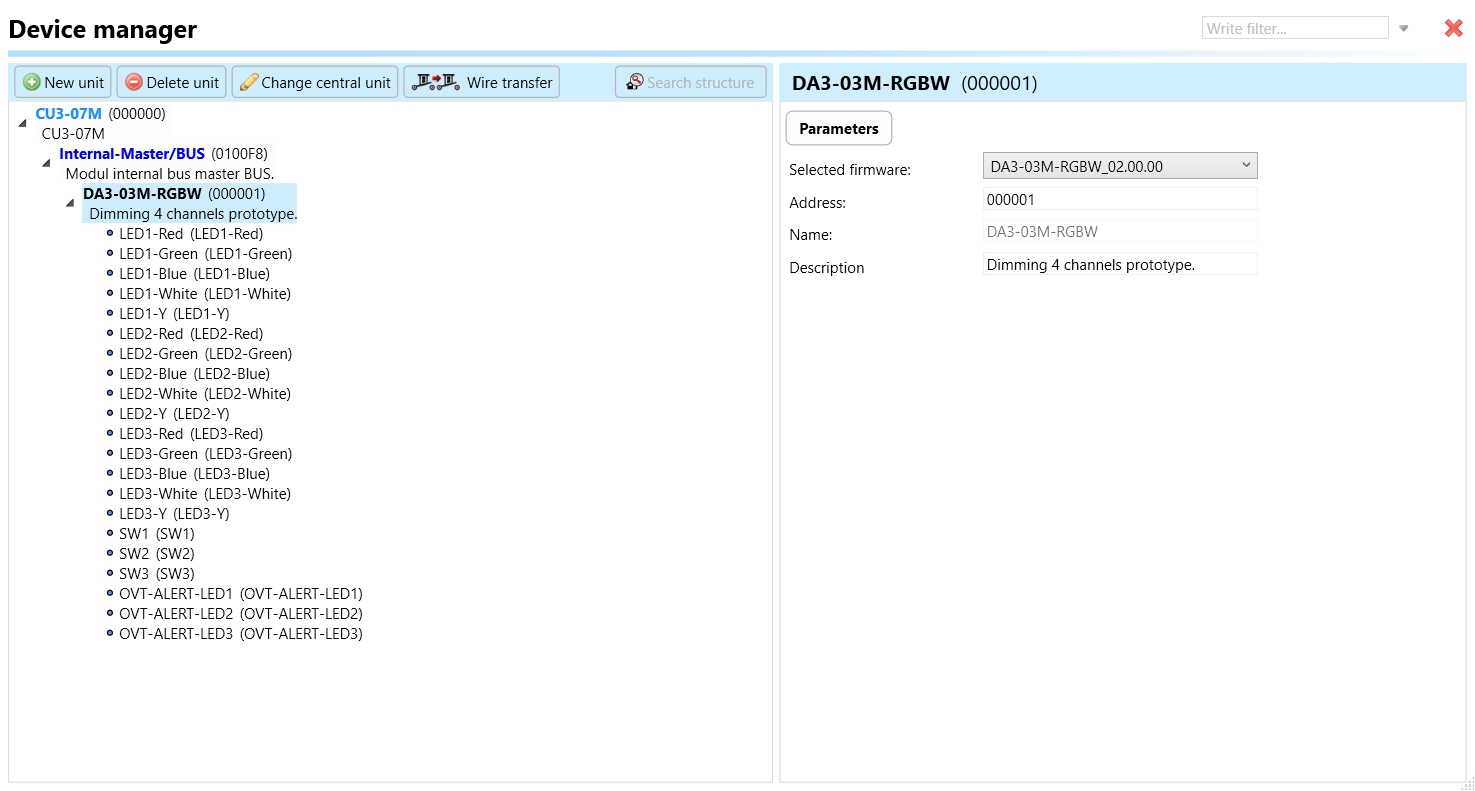
Clicking on the DA3-03M/RGBW (Fig.2), will navigate to the selected firmware, unit address, name, and description, along with other parameters as described below.
It is important to add the device address for proper communication with the unit. The Hexadecimal device address can be find from the device.
"LED1-Red," "LED1-Green," "LED1-Blue," "LED1-White," and "LED1-Y" refer to individual channels or parameters associated with the control of LED strips, particularly in RGBW LED strips. Here's an interpretation based on common conventions in LED strip control:
LED1-Red: This parameter corresponds to the control or setting for the red component of the RGBW LED strip connected to the first channel (LED1).
LED1-Green: Similarly, this parameter is associated with the control or setting for the green component of the RGBW LED strip connected to the first channel (LED1).
LED1-Blue: This parameter corresponds to the control or setting for the blue component of the RGBW LED strip connected to the first channel (LED1).
LED1-White: This parameter is associated with the control or setting for the white component of the RGBW LED strip connected to the first channel (LED1).
LED1-Y: The "Y" in "LED1-Y" represents a specific control of a single color of the LED Strips.
In RGBW LED strips, each channel typically corresponds to a specific color (Red, Green, Blue, and White), and additional channels additional channel represents a single color.
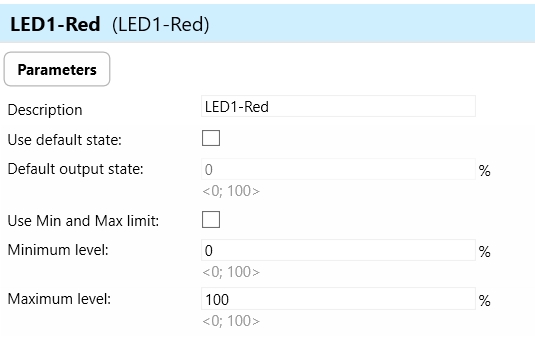
Use Default State: In the context of a dimming actuator, the term "default state" pertains to the pre-established or initial condition that the actuator adopts in the absence of communication from the bus or central unit. Enabling this function ensures that the relay automatically assumes its default state, which is set to OFF.
Default Output State: Upon choosing the "use default state" option, you will be prompted to specify the default output state. This refers to the pre-established or initial condition that the actuator adopts when there is no communication from the bus stop or central unit. Upon selecting this function, the relay will transition to its default output state, which, in this case, is set to ON.
Use Min and Max Limit: This parameter enables the utilization of minimum and maximum limits for output. When enabled, the actuator adheres to predefined minimum and maximum intensity levels for dimming control.
Minimum Level and Maximum Level: Defines the minimum and maximum intensity levels for output. These parameters establish the range within which dimming operations are constrained, ensuring optimal control and performance.
SW 1,2,3: This shows three switches, labeled as Switch 1, Switch 2, and Switch 3, associated with the dimmer. These switches provide a manual control interface for users to operate and adjust the behavior of the connected LED strips, offering convenience and flexibility in addition to centralized control through the iNELS system.
OVT-ALERT-LED1, 2 and 3: "OVT-ALERT-LED1,2 and 3" suggests an Over Temperature (OVT) Alert associated with LED1, 2, and 3 in the provided information about the DA3-03M/RGBW dimmer for LED strips. This alert feature is crucial for protecting the LED strips from potential damage due to overheating.
Exports for iNELS Cloud and APP
Setting Up Control and Monitoring for iNELS Cloud and iNELS App
It is possible to control and monitor all the bus units in iNELS cloud and iNELS app. There are two stages to set up this function. Stage one is to do configuration in iDM3 and stage 2 is to do Configuration in iNELS cloud page and iNELS app.
Configuration in iDM3.
1. Unit and Parameter Selection:
Begin by accessing the iDM3 interface on your PC connected to CU. Navigate to the Device Manager section and carefully select the units and parameters you wish to control. This step is essential for determining what gets exported to the iNELS cloud and app.

2. CU Configuration and Third-Party Settings :
After the above step, go to the CU configuration in the iDM3, and select the page for third-party settings.
Inside the third-party settings page, designate the port for cloud connection. Set the mode of operation and choose the numerical system as hexadecimal. Pay close attention to verifying and configuring all essential parameters for successful cloud export.
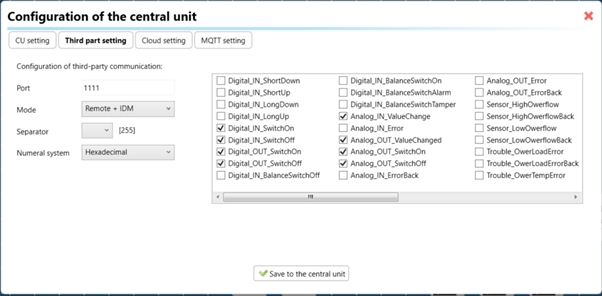
3. Cloud Settings:
Move on to the Cloud Settings section within iDM3.
Input the details of your iNELS cloud account. If you haven't created one, utilize the "New User" tab on the iNELS Cloud web page to establish a free account. (Inels Cloud - ElkoEP).
Select the mode and input the cloud account credentials. Save the project to the central unit to generate and store the export project file in the iNELS cloud account.
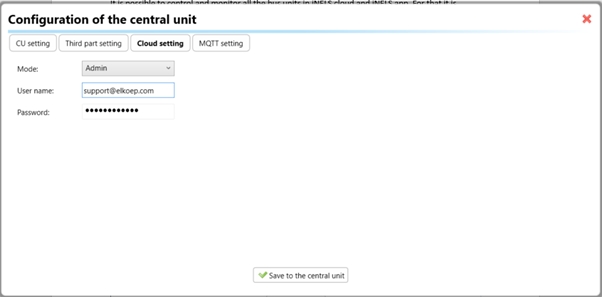
Configuration in iNELS cloud page and iNELS App.
1. Online Status Verification:
Once the cloud credentials and export settings in iDM3 are configured successfully, check the iNELS cloud account's Gateway section. Confirm that the Central Unit (CU) is online and that the export file has been automatically sent to the cloud under your account.

2. Device Creation in Cloud Platform:
In the cloud platform, you have to create new devices in order to control it remotely.
In the device tab, you will find the add device button, which can be used to associate export elements from IDM with the required types and icons.

After entering any name of the device, you select the icon, the MAC address of the communication gateway (in this case CU3), a specific type of device and the address of a specific function and element from the iNELS BUS system.
In order to be able to use the iNELS application to control the devices from CU over the local network or the cloud, it is necessary to create a room for bus devices for each central unit and add the devices into the room.
Follow these steps meticulously to ensure a seamless configuration process for controlling and monitoring all bus units through iNELS cloud and iNELS app.
3rd Party Integration with iNELS BUS
3rd Party Integration (MQTT)
iNELS units support MQTT integration on central units CU3-07M, CU3-08M, CU3-09M, and CU3-10M. It is necessary to select the devices and parameters for 3rd party integration on the device manager in the iDM.
Please note that you have an MQTT broker (local or cloud) running in the installation for this integration.
After you have a working MQTT broker you need to configure iNELS Central units to communicate with it. If you have no knowledge of what MQTT is, you can learn about it from MQTT Essentials articles. https://www.hivemq.com/mqtt/
There is a pre-installed MQTT broker in the iNLES bridge, it can be used to connect the iNELS Central units for integration in your projects.
Configuration in iDM3: Select units of 3rd Party integration.
Unit and Parameter Selection:
Begin by accessing the iDM3 interface on your PC connected to CU. Navigate to the Device Manager section and carefully select the units and parameters you wish to control. This step is essential for determining what gets exported to the 3rd party integration via MQTT.

2. CU Configuration and Third-Party Settings :
After the above step, go to the CU configuration in the iDM3, and select the page for third party settings.
Inside the third-party settings page, designate the port for third-party connection. Set the mode of operation and choose the numerical system as hexadecimal. Pay close attention to verifying and configuring all essential parameters for successful third-party integration.

3. MQTT Settings:
Move on to the MQTT Settings section within iDM3.
Input the details of your MQTT broker.
Select the mode and input the broker credentials such as IP, port username and password. Save the project to the central unit.
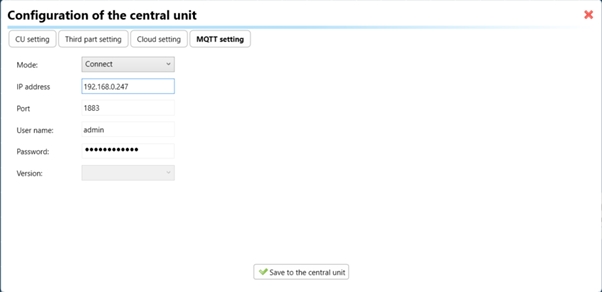
MQTT payload
For MQTT payload description please refer the link below. https://wiki.inels.com/v/inels-bus/3rd-party-integration/mqtt-payload-description-of-inels-bus-devices
Appendices
Last updated